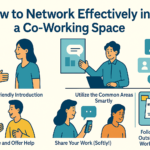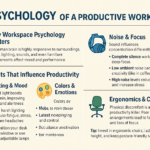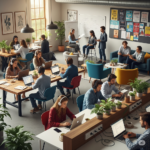Your workspace isn’t just a place where you sit and work—it’s an environment that shapes your thoughts, creativity, and efficiency. Studies in psychology and workplace design show that the way we organize and experience our workspace directly impacts focus, motivation, and productivity. Whether you’re working from home, a coworking space, or a private office, understanding the psychology of your workspace can help you build an environment that inspires success.
🧠 Why Workspace Psychology Matters
The human brain is highly responsive to surroundings. Colors, lighting, sounds, and even furniture arrangements affect mood and performance. A cluttered desk may lead to stress, while a well-organized space can enhance focus. By designing a workspace with psychological triggers in mind, you can reduce distractions, improve mental clarity, and maintain long-term productivity.
🌱 Key Elements That Influence Productivity
1. Lighting & Mood
-
Natural light boosts serotonin, improving mood and alertness.
-
Dim or harsh lighting can cause fatigue, stress, and even headaches.
-
Tip: Position your desk near a window or use warm, adjustable lamps.
2. Colors & Emotions
Colors play a powerful psychological role:
-
Blue & Green → Calm, focus, and creativity.
-
Yellow → Optimism and energy (great for brainstorming).
-
Red → Stimulates urgency and passion but can also increase stress.
-
Tip: Choose colors that reflect the type of work you do most often.
3. Organization & Decluttering
A messy desk can overwhelm the brain, creating mental clutter. An organized space reduces cognitive load, helping you process information faster and stay focused.
-
Tip: Keep only essentials on your desk and use storage for everything else.
4. Personalization & Identity
Adding personal touches—plants, photos, or art—creates a sense of belonging and control, which boosts motivation. But balance is key: over-personalization can lead to distractions.
-
Tip: Use 1–2 personal items that inspire positivity.
5. Noise & Focus
Sound influences concentration differently:
-
Complete silence works best for deep focus.
-
Low ambient noise can boost creativity (like in coffee shops).
-
High noise levels reduce efficiency and increase stress.
-
Tip: Use noise-canceling headphones or play soft instrumental music when needed.
6. Ergonomics & Comfort
Physical discomfort is a silent productivity killer. Poor seating or desk arrangements lead to fatigue, pain, and loss of focus.
-
Tip: Invest in ergonomic chairs, adjust screen height, and keep posture-friendly setups.
⚖️ The Balance Between Structure & Flexibility
A productive workspace isn’t just about discipline—it also needs flexibility. Too much rigidity can feel restrictive, while too much freedom may reduce efficiency. For example:
-
Structured Zones → A desk for focused tasks.
-
Flexible Zones → A lounge area for brainstorming or casual breaks.
Balancing these zones helps the brain switch between deep focus and creative flow.
✨ Creating Your Ideal Productive Workspace
-
Maximize natural light and add task lighting.
-
Use calming or energizing colors depending on your work style.
-
Declutter and keep your setup minimal yet personalized.
-
Reduce noise distractions with headphones or white noise.
-
Prioritize comfort and ergonomics for long working hours.
-
Create a balance between focus areas and relaxation zones.
🔑 Final Thought
Your workspace is more than a desk—it’s a psychological tool that influences how you think, feel, and perform. By intentionally designing your environment, you can create a space that doesn’t just look good but also keeps you motivated, focused, and inspired every day.





Leave a comment